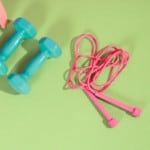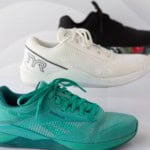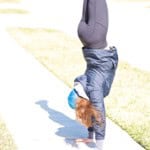
It took me 5 months to figure out that my daily pain was being caused by a herniated disc and what I needed to do to fix it. To help this NOT happen to you, here's my story plus 10 tips for navigating the best health care for a herniated disc.
My herniated disc journey began in February 2018, before I had a clue that I had any type of problem. At a normal workout I decided to do a set of back extensions on the apparatus where you tuck your feet in and raise your torso. I hadn't done this exercise in a while but decided that day I wanted to do something to strengthen my lower back. The next day however, I woke up and my back and left hamstring were in noticeable pain. As many regular exercisers often think, I thought I had simply strained a muscle and needed to stretch and rest it. The weird thing is that the pain didn't seem to match the action that I thought had caused it. It REALLY didn't make sense that my hamstring was also hurting badly. It took a couple of weeks to feel better and I returned to my normal routine.
Tip 1: If your pain doesn't match the offense, get a professional opinion.
At the beginning of June our family returned from our vacation in Utah on a lengthy, 5 hour flight. When I got home, my hamstrings felt really stiff, so I foam rolled them and went to bed. The next morning I woke up to significant back and hamstring pain. I didn't connect any dots yet but after a couple of weeks the pain subsided. The month of June was filled with a lot of sitting, as I studied and took the ACSM Personal Trainer certification exam and also did some crazy traveling with LOTS of sittings for a friend's funeral. My body was not quite right this whole time, but I still wasn't thinking something was really wrong.
Tip 2: If your pain is different or worse than anything you've had before, get a professional opinion.
In July I ran a 5K on the 4th and even had a few great workouts (those were my last visits at the gym for a really long time) until things went from bad to terrible.
Me and Coach were at an annual marriage retreat we attend, and I started to have significant pain down my left leg when I stood up from a seated position. Very weird. Halfway through the event I couldn't stand up without pain shooting down my left leg that made me stop, wince and wait for it to stop. My hamstring throbbed with pain making it difficult to sit.
We decided to get massages during our free time that day which seemed like it would help. It was during this massage though that I knew my problem was more than a sore muscle -- I was expecting for my back and leg muscles to be terribly tender to the touch, but they weren't, at all. I was hoping to feel amazing when it was over, but it hadn't changed my pain situation at all. This alerted me to the fact that my pain was not muscular in origin. Something else was going on.
Over the next few weeks I tried more rest without any change. I finally realized I needed some help and went to the chiropractor the first week of August to see if that could bring relief for what seemed like sciatic pain. I went for 3 visits and nothing changed. Then I went to my favorite massage therapist who is a genius about the body. She did all her magical moves and stretches and it helped a little, but the pain persisted when sitting and standing.
Finally, after much encouragement from Coach, I went to see an orthopedic surgeon. I was a month in to this excruciating pain and nothing was helping. The orthopedic poked and prodded me and had me walk this way and that way. Based on his physical assessment, and because I didn't have completely obvious signs of a herniated disc, he said I shouldn't get an MRI as I wasn't a candidate for surgery because I was "young, active and healthy." Perhaps it was piriformis syndrome, where one of the deep muscles in the glutes is so tight it was pressing on a nerve. He prescribed a course of strong anti-inflammatory drugs and physical therapy, which I started right away.
During this time, a good friend of mine was going through a similar situation. She was having terrible sciatica-like pain that kept her from her normal activities. She had an MRI done and discovered she had a herniated disc at L5/S1. Physical therapy, meds and rest were prescribed which made a big difference. She strongly encouraged me to get an MRI myself so I could know exactly what was going on as it helped her target her therapies immediately.
Tip 3: You are the customer in health care.
If you think you need imaging, don't stop asking until you get it.
Over the next month I faithfully went to PT, continued with chiropractic adjustments, and got massages. I also started acupuncture to see if it would calm my nerve pain, which it did, a little. My life began to revolve around getting therapies as I was so desperate for relief. I had a small improvement from everything I was doing, but the pain was impacting my everyday life and limiting what I could do.
I couldn't sit for more than about 5 minutes before the pain started throbbing. I watched most of our football games that season standing up. Driving became a major source of anxiety as it was so painful. I couldn't walk our new dog because she was too strong and it hurt when she pulled on the leash. My flexibility was severely limited and I could barely bend over before my leg pain flared up. I said "no" all the time to my kids because I hurt too much. I was fatigued despite sleeping well. It was awful and I was afraid this was my new normal.
Tip 4: If you know someone in chronic pain, extend them empathy.
It may not look like there's a problem on the outside, but it is sucking the life out of them on the inside.
One Saturday morning I woke up and immediately felt the pain shoot down my leg. I jumped out of bed hoping that standing would make it stop. No change. I laid flat on the floor, desperate for relief, but no change. Overtaken by the pain and discouragement I started to ugly cry there on the floor. I was doing everything I could possibly do to feel better and nothing was working. Something had to change because I couldn't live like this.
I returned to the orthopedic in September for a follow up and reported the lack of progress. I asked for an MRI because I wanted to know if there was something else going on. Unfortunately, he still refused to order me one because "it wouldn't change my treatment plan and I wasn't a surgery candidate." I left my appointment frustrated and hopeless because my only plan was to keep doing PT and cross my fingers it would help.
Tip 5: If you are not happy with what a health care provider is telling you, go to someone else.
It doesn't mean they are a bad provider, just not the right one for you.
Later that day I had an epiphany: I wanted an MRI and I could get someone else to order me one. This doctor or my therapists were not my only option. I made an appointment with my General Practitioner later that week and it was the best decision I could've made. You know what? She listened to my frustrations and was more than happy to order me an MRI. Hallelujah!
I also decided to switch physical therapists mid September. While I really liked my current therapist and knew they were knowledgeable, their approach didn't seem to be helping. My neighbor recommended someone who had really helped her, so I called and made an appointment. This was the second best decision I made.
From my first session with the new PT (of which I cried during the assessment because I was so frustrated and overwhelmed) I knew I was in the right hands and he could help me. His therapy approach was much more hands on and actually therapeutic as opposed to somewhat guessing at what might improved the situation. I started having a lot of manual therapy with things like a psoas releases, ASTYM, and cupping, which all seemed to help my pain. It was the first time I felt hope through this whole journey. I was also able to reduce the numbers of appointments I was going to as this new approach centralized almost all the other types of therapies. I did continue doing acupuncture separately.
Tip 6: If you're not benefitting from the work of a therapist (of any kind), try someone else. You have options.
The first week of October, I dragged by boys to an imaging center, and finally got the MRI I had wanted a month earlier. It took a week to get the results but they finally revealed the source of my pain: a badly herniated disc on the left side of spine between my L5 and S1 vertebrae with nerve compression.
What this means is that one of the discs in my spine was in essence leaking, or oozing, out and pinching my nerve that traveled down the back of my left leg.
The pain in my leg wasn't where my injury was; it was the result of my nerve being so aggravated from being compressed and abnormally firing up my muscles.
Nerve pain, my friends, is no freaking joke. Those nerves do not work correctly when they are hindered.
Now that I knew what was going on, it was time to figure out how to fix it. I presented the findings to my PT, and while it helped best identify therapy for relief, my problem was structural and wouldn't be fully corrected by PT alone. Bummer.
I sent my images to a family friend who also happens to be a top neurosurgeon in South Florida. As a favor, he looked it over for me and gave the opinion that I was a candidate for outpatient surgery to repair the problem.
Whoa. Wait a minute. Didn't doctor #1 say there was no way I was a surgery candidate? I was 36 years old; how could I need back surgery??
Tip 7: If you have a specialized problem, go to a specialized doctor, and, get 2 opinions.
I was not quite ready to accept that surgery was my outcome and if I did need it, wasn't keen on doing so 5 hours away from where I lived. My PT recommended a neurosurgery practice in town with a good reputation, so I called to make an appointment. Unfortunately, I couldn't get an appointment for another month and half. More waiting! More waiting meant more pain. There had to be something I could do.
Fortunately, my PT came through, again, and found out that another surgeon in that practice actually specialized in my situation and was much easier to get in with. I called back and got an appointment in a week with him.
Tip 8: Don't give up.
My appointment with this neurosurgeon was Thursday, November 1st. (For anyone still reading this saga and paying attention to the timeline, this is the beginning of month 5 with pain.) His opinion was actually the same as the other neurosurgeon: my herniated disc was causing the pain and it could be "easily" fixed with outpatient surgery called a microdiscectomy. PT was likely not going to heal it, if it hadn't already, and there were greater risks down the road for leaving it untreated. He performed this surgery "all the time" and had even had it done on himself many years earlier. He was hopeful that I would be able to return to my normal activities after healing. It was a very black/white, straight to the point appointment and I fought back my tears of emotion for the idea that I would be having back surgery.
Tip 9: Prepare to deal with surgeons
Surgeons are *usually* straight forward, cut to the chase people so don't expect warm fuzzies. It doesn't mean they are not caring, it is simply how they approach their job to perform at their best.
Within 24 hours I decided to have surgery and booked it for the last Friday in November. After the wave of emotions ran their course, I fully embraced this outcome and was ready to get it over with and begin healing.
Over the month of November I continued to go to physical therapy and acupuncture with the main objective to make my body as happy as possible. While I was anxious for surgery, I was also ready to feel better, whenever that would be.
To conclude, I want to share the list of things that brought me some relief from the pain related to my herniated disc pre-surgery. I tried A LOT of things!
Tip 10: Therapies and products that brought me pain relief:
- Physical therapy that included manual therapy of muscle releases, ASTYM, and cupping. A lot of people seemed to be intimidated by cupping but I thought it was helpful. You do bruise from it, although mine were not painful, and I could care less what my legs looked like if I FELT BETTER.
- Acupuncture of my low back and sciatic nerve down my left side brought short term relief from pain.
- Rolling my hamstring and glutes with lacrosse balls to get the smaller and deeper muscles. I had to fly for work a couple of times during this time and I literally sat on these balls during my whole flight. Having it right under my hamstring seemed to keep the pain at bay.
- I used an acupuncture mat almost every night before bed for about 20 minutes. It is covered in plastic points that are not comfortable to sit on but after about 5 minutes, you get used to. The idea is that it over stimulates your nervous system by all the contact which then triggers it to relax afterwards (I think). It seemed to help me, especially right before bed.
- It was a long journey that had brought me to this point, and I hope sharing it was helpful for you. I will write another post about actual surgery and recovery as that's another long story to tell. This was a nuts-and-bolts kind of post but if you would like more on my personal and spiritual journey through all this, please read my post 2018 Recap - Scars & Glory
If you have questions about any of this, please leave a comment or join the conversation on my Facebook page. I would also love to hear from anyone who also has gone through a similar experience. Leave a comment here or direct message me on Facebook.




















